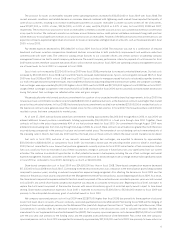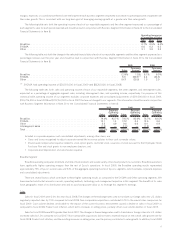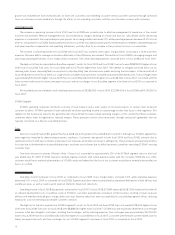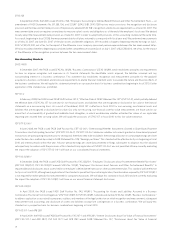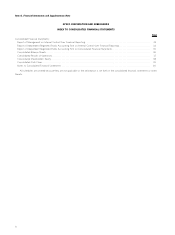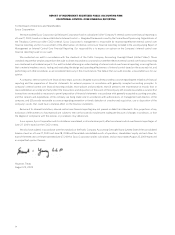Sysco 2009 Annual Report Download - page 45
Download and view the complete annual report
Please find page 45 of the 2009 Sysco annual report below. You can navigate through the pages in the report by either clicking on the pages listed below, or by using the keyword search tool below to find specific information within the annual report.returns, the effective annual rate of return on plan assets, developed using geometric/compound averaging, was approximately 7.4%, 2.0%, 0.5%
and (29.4)% over the 20-year, 10-year, 5-year and 1-year periods ended December 31, 2008, respectively. In addition, in eight of the last 15 years, the
actual return on plan assets has exceeded 10.0%. The rate of return assumption is reviewed annually and revised as deemed appropriate.
The expected return on plan assets impacts the recorded amount of net pension costs. The expected long-term rate of return on plan assets of
the Retirement Plan is 8.00% for fiscal 2010. A 1.0% increase (decrease) in the assumed rate of return for fiscal 2010 would decrease (increase)
Sysco’s net company-sponsored pension costs for fiscal 2010 by approximately $13,100,000.
Pension accounting standards require the recognition of the funded status of our defined benefit plans in the statement of financial position,
with a corresponding adjustment to accumulated other comprehensive income, net of tax. The amount reflected in accumulated other compre-
hensive loss as of June 28, 2008 was a charge, net of tax, of $220,913,000, which represented the net actuarial losses, prior service costs and
transition obligation remaining from the initial adoption of previous pension accounting standards as of that date. The amount reflected in
accumulated other comprehensive loss related to the recognition of the funded status of our defined benefit plans as of June 27, 2009 was a charge,
net of tax, of $346,107,000.
Changes in the assumptions, including changes to the discount rate discussed above, together with the normal growth of the plans, the impact
of actuarial losses from prior periods and the timing and amount of contributions, increased net company-sponsored pension costs by approximately
$25,800,000 in fiscal 2009. Increasing the net company-sponsored pension costs by approximately $4,300,000 in fiscal 2009 were additional
costs related to the merger of participants from a multi-employer pension plan into Sysco’s company-sponsored Retirement Plan (see Multi-
Employer Pension Plans under Other Considerations for further discussion). Decreasing the net company-sponsored pension costs by approx-
imately $7,200,000 in fiscal 2009 was a change in the SERP design. The net impact of all of these changes was a net increase in fiscal 2009 in
company-sponsored pension costs of $22,877,000. Changes in the assumptions, including changes to the discount rate discussed above, together
with the normal growth of the plans, the impact of actuarial losses from prior periods and the timing and amount of contributions are expected to
increase net company-sponsored pension costs in fiscal 2010 by approximately $37,000,000.
We made cash contributions to our company-sponsored pension plans of $95,776,000 and $92,670,000 in fiscal years 2009 and 2008,
respectively, including voluntary contributions to the Retirement Plan of $80,000,000 and $80,000,000 in fiscal 2009 and fiscal 2008,
respectively. Our minimum required contribution to the Retirement Plan for the calendar 2009 plan year is estimated at $95,000,000 to meet
ERISA minimum funding requirements. Sysco will be required to pay quarterly contributions for the calendar 2010 plan year, the first installment of
which must be made in fiscal 2010. We anticipate we will make $140,000,000 of contributions to the Retirement Plan in fiscal 2010. The estimated
fiscal 2010 contributions to fund benefit payments for the SERP and other post-retirement plans together are approximately $19,817,000.
Income Taxes
The determination of our provision for income taxes requires significant judgment, the use of estimates and the interpretation and application of
complex tax laws. Our provision for income taxes primarily reflects a combination of income earned and taxed in the various U.S. federal and state, as
well as foreign jurisdictions. Jurisdictional tax law changes, increases or decreases in permanent differences between book and tax items, accruals or
adjustments of accruals for unrecognized tax benefits or valuation allowances, and our change in the mix of earnings from these taxing jurisdictions
all affect the overall effective tax rate.
Prior to fiscal 2008, in evaluating the exposures connected with the various tax filing positions, we established an accrual when, despite our
belief that our tax return positions were supportable, we believed that certain positions may be successfully challenged and a loss was probable.
When facts and circumstances changed, these accruals were adjusted. Beginning in fiscal 2008, we adopted a new accounting standard, which
changed our accounting for uncertain tax positions. This accounting standard provides that a tax benefit from an uncertain tax position must be
recognized when it is more likely than not that the position will be sustained upon examination, including resolutions of any related appeals or
litigation processes, based on the technical merits of the position. The amount recognized is measured as the largest amount of tax benefit that has a
greater than 50% likelihood of being realized upon settlement. (See discussion under Note 17, Income Taxes, in the Notes to Consolidated Financial
Statements in Item 8).
Our liability for unrecognized tax benefits contains uncertainties because management is required to make assumptions and to apply judgment
to estimate the exposures associated with our various filing positions. We believe that the judgments and estimates discussed herein are reasonable;
however, actual results could differ, and we may be exposed to losses or gains that could be material. To the extent we prevail in matters for which a
liability has been established, or pay amounts in excess of recorded liabilities, our effective income tax rate in a given financial statement period could
be materially affected. An unfavorable tax settlement generally would require use of our cash and may result in an increase in our effective income
tax rate in the period of resolution. A favorable tax settlement may be recognized as a reduction in our effective income tax rate in the period of
resolution.
Vendor Consideration
We recognize consideration received from vendors when the services performed in connection with the monies received are completed and
when the related product has been sold by Sysco. There are several types of cash consideration received from vendors. In many instances, the vendor
consideration is in the form of a specified amount per case or per pound. In these instances, we will recognize the vendor consideration as a reduction
of cost of sales when the product is sold. In the situations where the vendor consideration is not related directly to specific product purchases, we will
25


